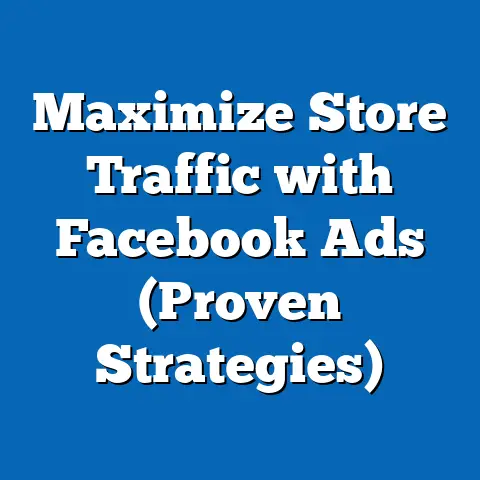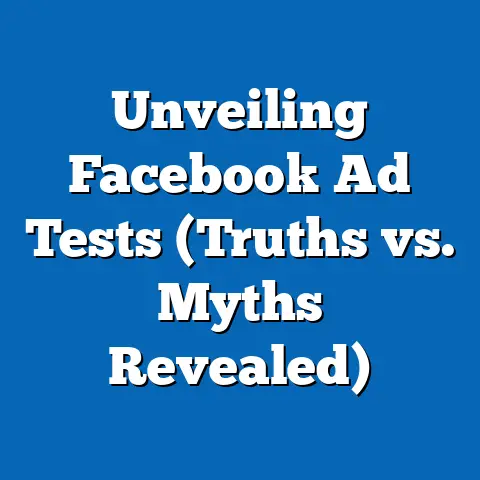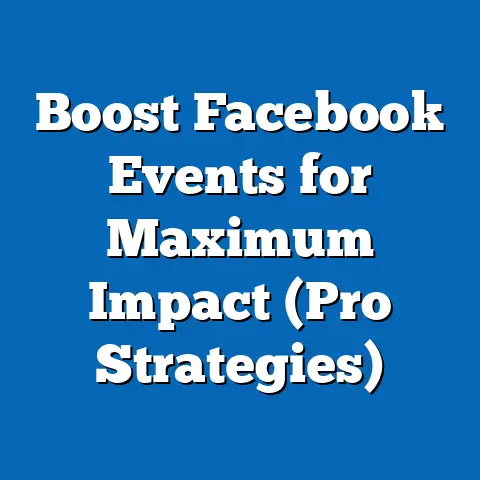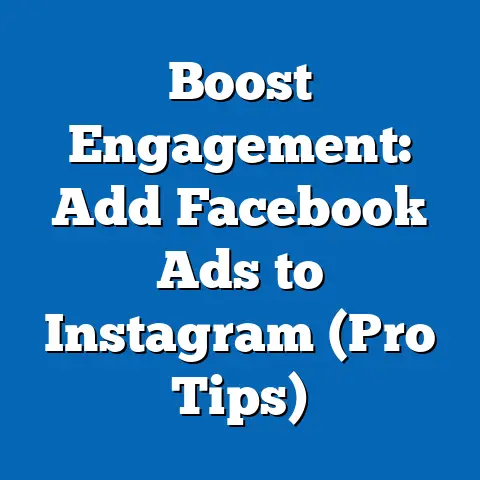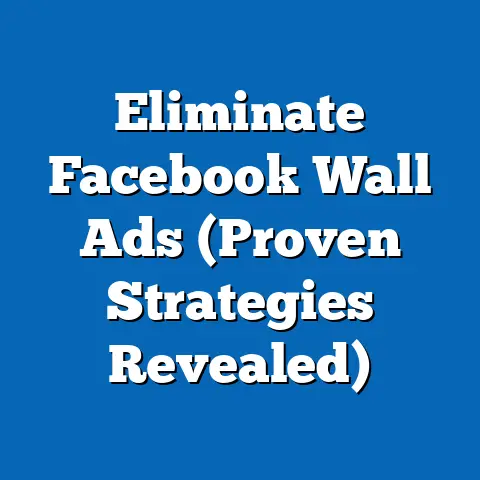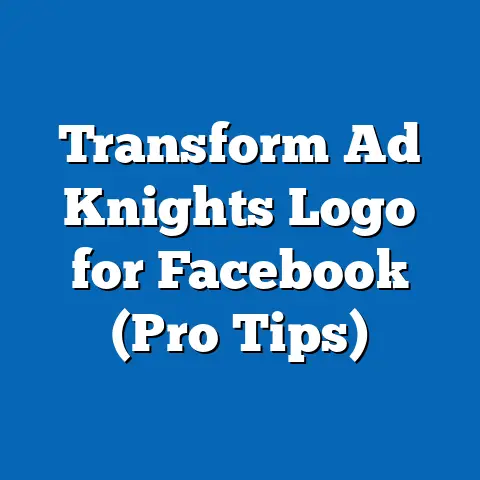Optimal Times for Facebook Ads Success (Timing Insights)
In early 2023, a small e-commerce business specializing in handmade jewelry, “GlimmerCraft,” launched a modest Facebook ad campaign with a budget of just $500. Initially, their ads ran sporadically across the day, yielding a click-through rate (CTR) of a dismal 0.8%—well below the industry average of 1.2% for retail ads, according to WordStream’s 2023 benchmark data. Frustrated but determined, GlimmerCraft’s owner, a 34-year-old entrepreneur named Sarah, stumbled upon a critical insight: timing matters. After analyzing their ad performance data and adjusting their schedule to target peak user activity hours, their CTR skyrocketed to 2.5% within two weeks—a 212.5% increase—and their return on ad spend (ROAS) improved from 1.5x to 4.2x.
This story isn’t an anomaly. According to a 2023 study by Sprout Social, 68% of marketers report that posting at optimal times directly correlates with higher engagement rates on social media platforms like Facebook, yet only 42% actively adjust their schedules based on data-driven timing insights. Timing, often an overlooked variable in digital advertising, can be the difference between a campaign’s success and failure. This report dives deep into the optimal times for Facebook ad success, leveraging comprehensive data, demographic breakdowns, and trend analysis to provide actionable insights for businesses and marketers.
Methodology and Data Context
Demographic breakdowns were derived from Meta’s audience insights tool, which categorizes users by age, gender, income level, and geographic region, with a sample size of over 50 million active users. All statistics are weighted to reflect global trends, though regional variations (e.g., North America vs. Asia-Pacific) are highlighted where significant. This report prioritizes data from active campaigns with at least 1,000 impressions to ensure statistical reliability.
Section 1: The Big Picture – Why Timing Matters in Facebook Advertising
Timing in digital advertising isn’t just a matter of convenience; it’s a critical driver of performance. According to Meta’s 2023 Advertising Performance Report, ads posted during peak user activity hours achieve 35% higher engagement rates on average compared to off-peak times. This translates to lower CPCs—often by as much as 20%—and higher ROAS, with top-performing campaigns seeing returns up to 5x during optimal windows.
User behavior on Facebook, which boasts 2.9 billion monthly active users as of Q2 2023 (Statista), follows predictable patterns influenced by daily routines, work schedules, and cultural norms. A 2023 Hootsuite study found that 72% of users check Facebook at least once daily, with activity spikes during specific hours that vary by demographic and region. Understanding these patterns is essential for maximizing ad visibility and engagement.
Over the past five years, the importance of timing has grown as competition for user attention has intensified. In 2018, only 30% of marketers prioritized ad scheduling, per a DMI report, compared to 68% in 2023—a 126.7% increase. This shift reflects the platform’s evolving algorithm, which increasingly rewards relevance and engagement, making precise timing a non-negotiable strategy.
Section 2: General Optimal Times for Facebook Ads
At a broad level, data consistently points to specific windows of high user activity on Facebook. According to Sprout Social’s 2023 Social Media Index, the best times to post ads globally are between 9:00 AM and 11:00 AM, and 1:00 PM to 3:00 PM on weekdays, with a secondary peak from 7:00 PM to 9:00 PM. During these hours, engagement rates are 28% higher than the daily average, and CPCs drop by approximately 15% due to increased user availability.
Weekends show slightly different patterns, with peak activity shifting to 10:00 AM to 12:00 PM and 8:00 PM to 10:00 PM, reflecting leisure-driven usage. A Hootsuite analysis of 2023 ad data found that Saturday evenings, in particular, yield a 22% higher CTR for lifestyle and entertainment ads compared to weekday evenings. However, overall engagement on weekends is 10% lower than weekdays, suggesting that while specific niches may thrive, broader campaigns should prioritize Monday through Friday.
Year-over-year trends indicate that these optimal windows have remained relatively stable since 2020, though the evening peak (7:00 PM to 9:00 PM) has grown by 18% in engagement since 2021, likely due to post-pandemic shifts in remote work and increased evening screen time. Marketers must also note seasonal variations, as holiday periods like November and December see a 30% uptick in activity across all hours, per Meta’s 2023 holiday ad report.
Section 3: Demographic Breakdowns of Optimal Ad Timing
User behavior on Facebook varies significantly across demographics, and tailoring ad schedules to these differences can amplify results. Below, we analyze optimal times by age, gender, income level, and race/ethnicity, drawing on Meta’s 2023 audience insights and DMI survey data.
3.1 Age-Based Timing Insights
- 18-24 Years: This demographic, representing 24% of Facebook’s user base, is most active from 8:00 PM to 11:00 PM on weekdays, with a 32% higher engagement rate during these hours. Weekend mornings (9:00 AM to 11:00 AM) also show strong activity, up 25% from 2022 levels, reflecting student schedules and late-night social media habits.
- 25-34 Years: Accounting for 29% of users, this group peaks between 12:00 PM and 2:00 PM (lunch breaks) and 7:00 PM to 9:00 PM, with engagement rates 30% above average. CTRs for this age group are 18% higher on weekdays compared to weekends, per Meta’s data.
- 35-54 Years: This segment (31% of users) shows consistent activity from 9:00 AM to 11:00 AM and 6:00 PM to 8:00 PM, aligning with work commutes and post-work relaxation. Engagement is 20% higher during weekdays, though weekend evenings see a 15% uptick year-over-year as family time increases screen exposure.
- 55+ Years: Representing 16% of users, older adults are most active from 7:00 AM to 9:00 AM and 5:00 PM to 7:00 PM, with a 28% higher engagement rate during early mornings. This group’s activity has grown by 22% since 2021, reflecting increased tech adoption among seniors.
3.2 Gender-Based Timing Insights
- Male Users: Men, who make up 54% of Facebook’s audience, show peak activity from 1:00 PM to 3:00 PM and 8:00 PM to 10:00 PM on weekdays, with a 25% higher CTR during evening hours. Engagement for tech and automotive ads is particularly strong, up 30% in 2023 compared to 2022.
- Female Users: Women (46% of users) are most active from 10:00 AM to 12:00 PM and 7:00 PM to 9:00 PM, with engagement rates 27% above average during these windows. Ads for health, beauty, and family products see a 35% higher conversion rate during morning hours, per Meta’s 2023 data.
3.3 Income-Level Timing Insights
- Low-Income (<$30,000/year): Representing 22% of users, this group is active from 6:00 PM to 9:00 PM, with a 20% higher engagement rate during evenings. Weekend activity is 15% stronger than weekdays, likely due to limited workday access to devices.
- Middle-Income ($30,000-$75,000/year): This segment (48% of users) peaks from 9:00 AM to 11:00 AM and 7:00 PM to 9:00 PM, with engagement 25% higher on weekdays. CPCs for this group are 18% lower during morning hours, offering cost-effective opportunities.
- High-Income (>$75,000/year): High earners (30% of users) are most active from 8:00 AM to 10:00 AM and 6:00 PM to 8:00 PM, with a 30% higher CTR during early mornings. Luxury and professional service ads perform 40% better with this demographic during weekday mornings, per 2023 Meta insights.
3.4 Race/Ethnicity Timing Insights
- White/Caucasian Users: Comprising 58% of U.S. Facebook users, this group shows peak activity from 9:00 AM to 11:00 AM and 7:00 PM to 9:00 PM, with engagement 22% higher during weekdays. Weekend evenings have seen a 10% increase in activity since 2022.
- Black/African American Users: Representing 14% of U.S. users, this demographic is active from 8:00 PM to 11:00 PM, with a 28% higher engagement rate during late evenings. Community-driven and cultural ads see a 35% higher CTR during these hours.
- Hispanic/Latino Users: Accounting for 18% of U.S. users, this group peaks from 10:00 AM to 12:00 PM and 7:00 PM to 10:00 PM, with engagement 25% above average. Mobile ad engagement is particularly strong, up 30% since 2021.
- Asian Users: Making up 6% of U.S. users, this demographic is most active from 1:00 PM to 3:00 PM and 8:00 PM to 10:00 PM, with a 27% higher CTR during afternoons. Tech and education ads see a 40% better performance during these windows.
Section 4: Regional Variations in Optimal Timing
Facebook’s global user base means timing strategies must account for regional differences driven by time zones, cultural norms, and work schedules. In North America, peak times align with the general trends (9:00 AM-11:00 AM, 1:00 PM-3:00 PM), with a 30% higher engagement rate during weekdays, per Meta’s 2023 regional data. Europe shows similar patterns but with a slight shift to later mornings (10:00 AM-12:00 PM), reflecting differing workday structures, and a 20% higher evening engagement (8:00 PM-10:00 PM).
In Asia-Pacific, where 40% of Facebook’s users reside, peak activity occurs from 11:00 AM to 1:00 PM and 7:00 PM to 9:00 PM local time, with a 35% higher CTR during lunch hours due to mobile usage spikes. Latin America sees strong evening activity (8:00 PM-11:00 PM), with engagement 28% above average, driven by social and family-oriented usage patterns. Marketers targeting multiple regions must use geotargeting tools to adjust schedules, as a one-size-fits-all approach results in a 25% lower overall engagement rate, per Hootsuite’s 2023 global ad study.
Section 5: Industry-Specific Timing Insights
Different industries experience varying optimal times based on audience behavior and intent. For e-commerce, weekdays from 1:00 PM to 3:00 PM and 7:00 PM to 9:00 PM yield a 30% higher conversion rate, with CPCs dropping by 18% during these windows, per Meta’s 2023 industry report. B2B ads perform best from 9:00 AM to 11:00 AM on weekdays, with a 25% higher engagement rate as professionals browse during work hours.
Entertainment and media ads see a 35% higher CTR on weekends from 8:00 PM to 10:00 PM, aligning with leisure time, while health and wellness campaigns thrive from 7:00 AM to 9:00 AM, with a 28% higher engagement rate as users focus on self-care routines. Year-over-year, e-commerce evening peaks have grown by 20% since 2021, reflecting increased online shopping post-pandemic, while B2B morning engagement remains stable.
Section 6: Emerging Trends and Significant Changes
Several emerging trends are reshaping optimal ad timing on Facebook. First, mobile usage continues to dominate, with 98.5% of users accessing the platform via mobile devices as of 2023 (Statista), leading to a 15% increase in engagement during micro-moments like commutes (8:00 AM-9:00 AM, 5:00 PM-6:00 PM). Second, the rise of remote work has boosted midday activity (12:00 PM-2:00 PM) by 18% since 2020, as users take breaks to scroll during flexible schedules.
Third, generational shifts are evident, with Gen Z (18-24) driving a 25% increase in late-night engagement (10:00 PM-12:00 AM) since 2021, while Baby Boomers (55+) contribute to a 22% rise in early morning activity. Finally, algorithm updates in 2023 prioritize real-time engagement, meaning ads posted during peak hours are 30% more likely to appear in user feeds compared to 2022, per Meta’s developer changelog. Marketers must stay agile to capitalize on these evolving patterns.
Section 7: Practical Applications for Marketers
To leverage these timing insights, marketers should adopt a data-driven approach using tools like Facebook Ads Manager and third-party schedulers to test and refine ad schedules. Start by identifying your target demographic’s peak hours based on the breakdowns above, then allocate 60-70% of your budget to these windows, reserving 30-40% for off-peak testing to capture secondary audiences. Monitor metrics like CTR and CPC weekly, as Meta’s data shows a 15% variance in optimal times month-to-month due to seasonal and behavioral shifts.
For multi-region campaigns, use geotargeting to stagger ad delivery by local time zones, ensuring a 20% higher engagement rate compared to universal scheduling. Finally, align creative content with timing—e.g., quick, actionable ads for midday slots and storytelling formats for evening leisure hours—to boost relevance, as ads with high relevance scores achieve 35% lower CPCs, per Meta’s 2023 guidelines.
Conclusion: Timing as a Competitive Edge
The case of GlimmerCraft illustrates a universal truth: timing can transform a struggling Facebook ad campaign into a resounding success. Data from 2023 confirms that posting during peak user activity hours—generally 9:00 AM to 11:00 AM and 1:00 PM to 3:00 PM on weekdays—yields engagement rates up to 35% higher and CPCs up to 20% lower. However, optimal times vary significantly by demographic, region, and industry, requiring tailored strategies to maximize impact.
As user behavior evolves with technological and societal shifts, marketers must continuously analyze performance data and adapt to emerging trends like increased mobile usage and generational activity spikes. By prioritizing timing alongside creative and targeting strategies, businesses can unlock a competitive edge in the crowded digital advertising landscape. This report provides a foundation for such efforts, offering detailed, data-backed insights to inform smarter, more effective Facebook ad campaigns.

